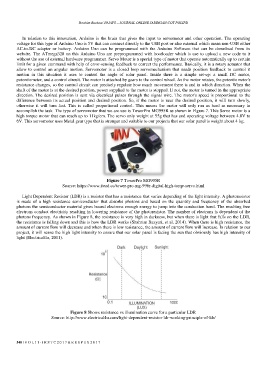Page 541 - eProceeding for IRSTC2017 and RESPeX2017
P. 541
Ibrahim Burhan/ JOJAPS – JOURNAL ONLINE JARINGAN COT POLIPD
In relation to this innovation, Arduino is the brain that gives the input to servomotor and other operation. The operating
voltage for this type of Arduino Uno is 5V that can connect directly to the USB port or also external which mean non-USB either
AC-to-DC adapter or battery. Arduino Uno can be programmed with the Arduino Software that can be download from its
website. The ATmega328 on this Arduino Uno are preprogrammed with bootloader which is use to upload a new code to it
without the use of external hardware programmer. Servo Motor is a special type of motor that operate automatically up to certain
limit for a given command with help of error-sensing feedback to correct the performance. Basically, it is a rotary actuator that
allow to control an angular motion. Servomotor is a closed loop servomechanism that needs position feedback to control it
motion in this situation it uses to control the angle of solar panel. Inside there is a simple set-up: a small DC motor,
potentiometer, and a control circuit. The motor is attached by gears to the control wheel. As the motor rotates, the potentiometer's
resistance changes, so the control circuit can precisely regulate how much movement there is and in which direction. When the
shaft of the motor is at the desired position, power supplied to the motor is stopped. If not, the motor is turned in the appropriate
direction. The desired position is sent via electrical pulses through the signal wire. The motor's speed is proportional to the
difference between its actual position and desired position. So, if the motor is near the desired position, it will turn slowly,
otherwise it will turn fast. This is called proportional control. This means the motor will only run as hard as necessary to
accomplish the task. The type of servomotor that we are use is TowerPro MG995R as shown in Figure 7. This Servo motor is a
high torque motor that can reach up to 11kg/cm. The servo only weight at 55g that has and operating voltage between 4.8V to
6V. This servomotor uses Metal gear type that is stronger and suitable to our projects that our solar panel is weight about 4 kg.
Figure 7 TowerPro MG995R
Source: https://www.itead.cc/tower-pro-mg-996r-digital-high-torqe-servo.html
Light Dependent Resistor (LDR) is a resistor that has a resistance that varies depending of the light intensity. A photoresistor
is made of a high resistance semiconductor that absorbs photons and based on the quantity and frequency of the absorbed
photons the semiconductor material gives bound electrons enough energy to jump into the conduction band. The resulting free
electrons conduct electricity resulting in lowering resistance of the photoresistor. The number of electrons is dependent of the
photons frequency. As shown in Figure 8, the resistance is very high in darkness, but when there is light that falls on the LDR,
the resistance is falling down and this is how the LDR works (Shahriar Bazyari, et al. 2014). When there is high resistance, the
amount of current flow will decrease and when there is low resistance, the amount of current flow will increase. In relation to our
project, it will sense the high light intensity to ensure that our solar panel is facing the sun that obviously has high intensity of
light (Electrical4u, 2011).
Figure 8 Shows resistance vs illumination curve for a particular LDR
Source: http://www.electrical4u.com/light-dependent-resistor-ldr-working-principle-of-ldr/
540 | V O L 1 1 - I R S T C 2 0 1 7 & R E S P E X 2 0 1 7

